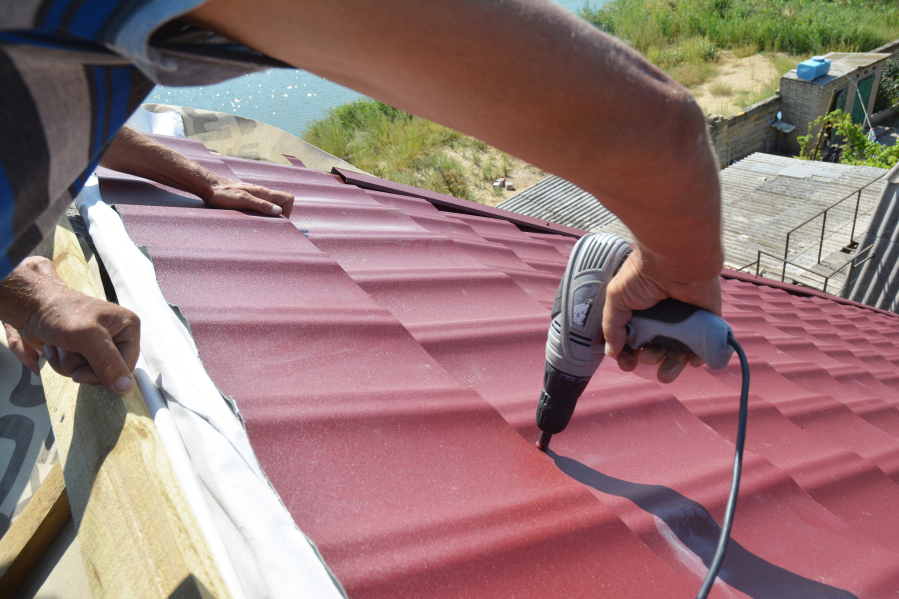A new roof is an expensive endeavor. It’s rarely less than a four-figure job, and costs can climb as sky-high as $46,000. Of course, given the importance of a roof to a home, you shouldn’t skimp on fixing it, but it sure would be nice to save. Which leads to the thought: Can repairing/replacing your roof be a DIY project? Should you even consider doing your own roofing?
Here’s when you should, when you shouldn’t, and what you should know about roof replacements and repairs to help you decide.
When considering a DIY roof repairs, here are some of the advantages and disadvantages to weigh.
Pros of DIY roofing
You’ll save money: Anytime you can do a home improvement project yourself, you’ll save on labor costs. And with roofs, the labor costs are considerable — overall, often 60 percent of the price tag, according to Angi, the contractor-search site. The average expenditure for having a pro replace your roof is $10,530, vs $5,682 to do it yourself, according to the U.S. Census Bureau’s latest American Home Survey. Therefore, doing it on your own can save you almost half the cost.
You’ll avoid delays: If you need a repair done sooner rather than later — you’re seeing leaks, feeling drafts, or noticing buckling — waiting around for a contractor might not be a luxury you have. (And you can bet some companies will charge more for rush service.) Doing it yourself allows you to address the problem fast, containing the damage and protecting your home.
Cons of DIY roofing
Roof work is dangerous: At the risk of stating the obvious: Roofing takes place high up, and if you fall, it’s a long way down. You may think you’ve a head for heights, but traversing your roof can be tricky, especially if it has a steep slope or multiple levels. You’ll also need to be in good shape, as bending, climbing and hauling are continuously required — often under hot or windy conditions.
Roof work is difficult: Being a roofer requires strength and dexterity: Bench-pressing 75 pounds at the gym is not the same as hefting 75-pound packages of shingles up a rickety ladder. And while roof work itself isn’t brain surgery, it does involve many steps and you can incur surprises along the way — like discovering some serious structural damage to the roof after you strip off the old shingles. You’re also going to need some specialized tools to make the job go easier and faster : roofing nailer, air compressor, air hose, caulk gun, extension ladder and snips, to name just a few. Be prepared to haul many of them up the ladder too.
Can you reroof a house yourself?
Replacing a roof is a large, multifaceted project: It typically involves removing the existing shingles, making spot repairs to the underlying shingles and structure, and then installing new shingles. But there are two key elements to consider to see if undertaking it yourself is worthwhile.
Roof size and orientation
The bigger your roof, the more materials you’ll need. And the more time you’ll invest in transporting and installing them.
Another factor to consider is the angle of your roof, or slope, as the pros say. Low-sloped roofs are easier to install shingles on because of their flatter angles. Conversely, higher-angled roofs are more time-consuming and difficult. If your roof has lots of extra elements, like chimneys, dormers or skylights, the job gets more complicated, too.
Roofing material
There are a variety of roofing materials to choose from, such as asphalt, metal, wood, clay, and slate. And some are kinder to DIY-ers than others. Lightweight materials like asphalt or wood shake are going to be easier to install than heavier or more ornate materials like metal or slate.
In general, asphalt shingles — though not the most glam — are affordable and surprisingly durable, lasting on average up to 30 years. If you decide to go this route, pay close attention to the hail rating, as not all asphalt shingles are the same quality. Look for ones that have a UL 2218 Class 3 or 4 rating.
Meanwhile, metal roofs offer exceptional durability of up to 50 years. And they can be hurricane and hail resistant, offering your home protection in the severest weather conditions. But with metal roofs, you cannot replace just one shingle. Instead, you have to do an entire panel based on the way they’re joined together.
Other things to consider
You might need a permit before you begin work. You can check with your municipal authorities to see if they require one — and if they’ll give one to an amateur. And, if you have an HOA, make sure to receive their approval, too. They may insist on you hiring a professional.
Also, you’ll want to check your homeowner’s insurance policy. Most won’t cover roof repairs and replacements due to normal aging and wear-and-tear, but many will cover roofing damage caused by common perils, such as hail, fire, or winds. However, they may require a professional bonded and licensed roofer do any work. If your roof gets damaged further by your efforts, they might not cover that. They probably wouldn’t cover bills from any injuries you incur, either.
What sort of roof repairs can you DIY?
Here are some simple ones you can undertake with minimal investment:
Replace shingles: Replacing a shingle basically involves removing the nails and breaking the seal if needed. Next, remove the shingle and replace it with a fresh one.
Fix the flashing: As you inspect your shingles, give the flashing a quick examination to see if it’s leaking. If you notice any leaks, reseal its joints using a caulk gun filled with roofing cement.



